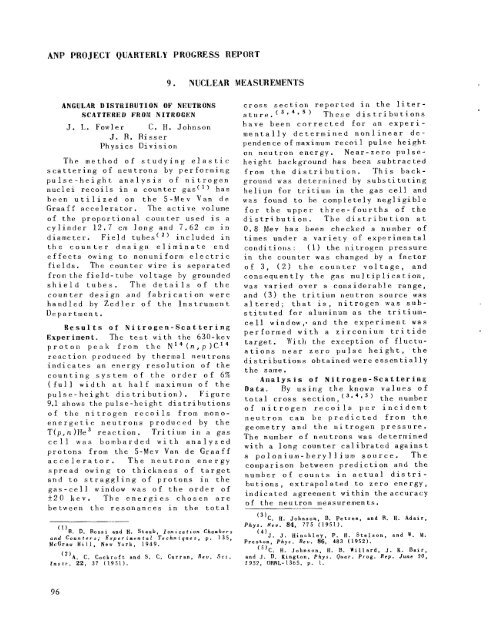the Molten Salt Energy Technologies Web Site
the Molten Salt Energy Technologies Web Site
the Molten Salt Energy Technologies Web Site
You also want an ePaper? Increase the reach of your titles
YUMPU automatically turns print PDFs into web optimized ePapers that Google loves.
ANP PROJECT QUAHTEWLY PROGRESS REPORT<br />
ANGULAR DISTRIBUTION OF NEUTRONS<br />
SCATTERED FROM NITROGEN<br />
J. L. Fowler @. H. Johnson<br />
J. R. Risser<br />
Physics Division<br />
The method of studying elastic<br />
scattering of neutrons by performing<br />
pulse-height, analysis of nitrogen<br />
nuclei recoils in a counter gas(') has<br />
been utilized on <strong>the</strong> 5-Mev Van de<br />
Graaff accelerator. The active volume<br />
of <strong>the</strong> proportional counter used is a<br />
cylinder 12.7 cm long and 7.62 cm in<br />
diameter. Field tubes(2) included in<br />
<strong>the</strong> counter design eliminate end<br />
effects owing to nonuniform electric<br />
fields. The counter wire is separated<br />
from <strong>the</strong> field- tube voltage by grounded<br />
shield tubes, The details of <strong>the</strong><br />
counter design and fabrication were<br />
handled by Zedler of <strong>the</strong> Instrument<br />
De par tmen t .<br />
Results of Nitrogen-Scattering<br />
Experiment. The test with <strong>the</strong> 630-kev<br />
proton peak from <strong>the</strong> N14 (n,p )CI4<br />
reaction produced by <strong>the</strong>rmal neutrons<br />
indicates an energy resolution of <strong>the</strong><br />
counting system of <strong>the</strong> order of 6%<br />
(full width at half maximum of <strong>the</strong><br />
pulse-height distribution). Figure<br />
9.1 shows <strong>the</strong> pulse-height distributions<br />
of <strong>the</strong> nitrogen recoils from mono-<br />
energetic neutrons produced by <strong>the</strong><br />
T(p,n)He3 reaction. Tritium in a gas<br />
cell was bombarded with analyzed<br />
protons from <strong>the</strong> 5-Mev Van de Graaff<br />
accelerator. The ncutron energy<br />
spread owing to thickness of target<br />
and to straggling of protons in <strong>the</strong><br />
gas-cell window was of <strong>the</strong> order of<br />
rt20 kev. The energies chosen are<br />
between <strong>the</strong> resonances in <strong>the</strong> total<br />
("€3. D. Rossi and H. Staub, Ionizatron Chambers<br />
and Counters; Experimental Techniques, p. 135,<br />
McGrav Hill, New York. 1949.<br />
(')A. C. Cockroft and S. C. Curran. Rev. SCZ.<br />
Tnstr. 22. 37 (1951).<br />
96<br />
9. NUCLEAR MEASIjREMENTS<br />
cross section reported in <strong>the</strong> litera<br />
t ~ r e . ( ~ ' ~ These ' ~ ) distributions<br />
have been corrected for an experimentally<br />
determined nonlinear dependence<br />
of maximum recoil pulse height<br />
on neutron energy. Near-zero pulseheight<br />
background has been subtracted<br />
from <strong>the</strong> distribution. This background<br />
was determined by substituting<br />
helium for tritium in <strong>the</strong> gas cell and<br />
was found to be completely negligible<br />
for <strong>the</strong> upper three-fourths of <strong>the</strong><br />
distribution. The distribution at<br />
0.8 Mev has been checked a number of<br />
times under a variety of experimental<br />
conditions : (I) <strong>the</strong> nitrogen pressure<br />
in <strong>the</strong> counter was changed by a factor<br />
of 3, (2) <strong>the</strong> counter voltage, and<br />
consequently <strong>the</strong> gas mu1 tiplication, was varied over a considerable range,<br />
and (3) <strong>the</strong> tritium neutron source was<br />
a1 tered; that is, nitrogen was substituted<br />
for aluminum as <strong>the</strong> tritiumcell<br />
window,. and <strong>the</strong> experiment was<br />
performed with a zirconium tritide<br />
target. \YY;L~ <strong>the</strong> exception of fluctuations<br />
near z e r ~ pulse height, <strong>the</strong><br />
di s tr i bu t ion s obtained were e ss en ti a 1 1 y<br />
<strong>the</strong> same.<br />
Analysis of N i t rogcn- Scat ter ing<br />
Data. By using <strong>the</strong> known values of<br />
total cross <strong>the</strong> number<br />
of nitrogen recoils per incident<br />
neutron can be predicted from <strong>the</strong><br />
geometry and <strong>the</strong> nitrogen pressure.<br />
The number of neutrons was determined<br />
with a long counter calibrated against<br />
a polonium-beryllium source. The<br />
comparison between prediction and <strong>the</strong><br />
number of counts in actual distributions,<br />
extrapolat,ed to zero energy,<br />
indicated agreement within <strong>the</strong> accuracy<br />
of <strong>the</strong> neutron measurements.<br />
(3)C. H. Johnson, B. Petree, and R. H. Adair.<br />
Phys. Heu. 84, 775 (1951).<br />
(4)J. J. Hinchley, P. M. Stelson, and W. XI.<br />
Preston, Phys. Rev. 86, 483 (1952).<br />
(5)C. H. Johnson, 8. B. Willard, J. K. Bair,<br />
and J. D. Kington, Phys. Quar. Prog. Rep. June 20,<br />
1952. ORNL-1365. p. 1.



![Review of Molten Salt Reactor Physics Calculations [Disc 2]](https://img.yumpu.com/21979492/1/190x247/review-of-molten-salt-reactor-physics-calculations-disc-2.jpg?quality=85)












